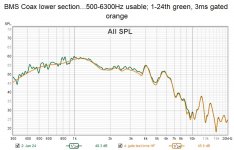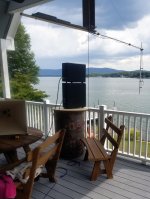In practical terms you are missing the point. The Q's that would be "significantly" affected would be on the order of 50 or more. No audio device with that kind of Q would ever be used in reality. For typical Q's of horn systems, the effect would only be a few % - virtually nothing noticeable by eye, let alone the ear.
In practical terms you are missing the point. The Q's that would be "significantly" affected would be on the order of 50 or more. No audio device with that kind of Q would ever be used in reality. For typical Q's of horn systems, the effect would only be a few % - virtually nothing noticeable by eye, let alone the ear.
In practical terms, I think you are obfuscating the point.
Point being, you can have time resolution or frequency resolution, not both.
And gating takes away freq resolution significantly, for Q's way, way, lower than 50.
Here's a comparison of the lower section of a BMS coax, a device used in reality, good from 500Hz to about 6kHz.
Same measurement. Green is smoothed to 1/24th. Orange is 3ms gated.

You can say what you want, but below 1000Hz, the gated curve doesn't give me enough frequency domain info, to do good work with.
I ask you again, please don't frame your view on gating as pure truth, without specifying the narrowed set of conditions for which it holds.
The science of the time /frequency tradeoff isn't just about HF horns....especially in a world that is asking horn/CD combos to dig ever lower in frequency.
Many of us watching this thread have hopes it will lead into larger horns with lower frequency control, than can be made into synergy designs.
dude you're talking to one of the foremost brains on audio. honestly this is just cringe. what you're saying is obvious to somebody familiar with the math (and how to avoid it) and just adding confusion to somebody who's just trying to get a good measurement without knowing the details. Again. we could remove the last few pages and actually improve the quality of the information being provided to newcomers.
you're just trying to defend yourself, not add to quality information available here. you're not saving face.
you're just trying to defend yourself, not add to quality information available here. you're not saving face.
You can.. but you have to do measurement in big, reflection free space 🙄Can't have both, in high resolution, at the same time, huh?
No, waterfall makes it only worse.Waterfall plot can have both?
Frankly, I'd say that none of those curves is truly representative of the actual device. Orange is too smoothed and the green seems to include too much of the environment.Here's a comparison of the lower section of a BMS coax, a device used in reality, good from 500Hz to about 6kHz.
Same measurement. Green is smoothed to 1/24th. Orange is 3ms gated.
View attachment 953439
The only way to get reliable data is indeed to measure in a large space with a long enough gating time (or in anechoic chamber of course but that is also not without its problems).
My take is gating is mostly worthless.
Mark100 - you remember saying this? And then getting applauded from the "peanut gallery" for it. When you say things as outrageous as this you must understand that people like me are going to call you out on it. I am not going to read something that is not only false, but exactly the wrong thing to do and not say anything. These kinds of fallacious claims need to be corrected.
The only way to get reliable data is indeed to measure in a large space with a long enough gating time (or in anechoic chamber of course but that is also not without its problems).
Not "the only way". I am working on the cancellation of reflections at LFs which, when done, will allow for very accurate measurements in virtually any space.
Frankly, I'd say that none of those curves is truly representative of the actual device. Orange is too smoothed and the green seems to include too much of the environment.
The only way to get reliable data is indeed to measure in a large space with a long enough gating time (or in anechoic chamber of course but that is also not without its problems).
I agree. That measurement was the first thing I could find made with REW, and was taken indoors for an unknown reason. I wanted to use REW because of my previous IR Window panel reference.
Here's the outdoor setup I use for measuring/tuning. Always with dual channel, other than a rare REW sine sweep for distortion. Pink noise is so much easier on the neighborhood, than siren sweeps Lol.
The 3 mic boom rotates, but I usually rotate with a turntable.
It's a very handy mostly reflection free setup, for 100Hz and up work.
Below 100Hz, for subs, I just drag them out onto the driveway and measure at 4m, well away from buildings, cars, etc.

OK 🙂Not "the only way". I am working on the cancellation of reflections at LFs which, when done, will allow for very accurate measurements in virtually any space.
So how long reflection-free time will this method need to work without any resolution constraints in the range 300 - 1000 Hz?
without any resolution constraints in the range 300 - 1000 Hz?
No system of analysis can do that. I don't yet know the limitations, only that, in theory, it can be done. As usual implementation will always have its limitations. The goal is "better" results, not "perfect" results.
Seeking "perfection" is the enemy of obtaining "improvement."
Mark100 - you remember saying this? And then getting applauded from the "peanut gallery" for it. When you say things as outrageous as this you must understand that people like me are going to call you out on it. I am not going to read something that is not only false, but exactly the wrong thing to do and not say anything. These kinds of fallacious claims need to be corrected.
Earl, i apologize for my over the top comment. Twas way too strong.
I continue to think gating is greatly overused, for the reason discussed.
I wish you had acknowledged gating's frequency resolution decrease, as I presented in the post just quoted. Instead of saying it's built on a fallacious premise, with a subsequent switch to defining resolution as time domain resolution.
I deserve to be corrected for being over the top, and would probably have quickly said so if confronted for that.
I do not feel like i've said anything inaccurate or misleading, and have been challenged as if I did. I'm happy to stand corrected, but until i believe I've been corrected, I stand by what i believe to be true.
Peace 🙂
Gating is not perfect, but it is the best technique that we have right now (but not the only one*) and the reason that it is so widely used is because it works so well.
* some years back some software (I forgot) used a technique that I wrote about wherein the impulse response is extended into the gated domain using advanced signal processing techniques based on Prony style regression. I understand that it worked very well.
* some years back some software (I forgot) used a technique that I wrote about wherein the impulse response is extended into the gated domain using advanced signal processing techniques based on Prony style regression. I understand that it worked very well.
Now I see I should have written "the only one readily available to most of us at the moment" 😛
Seeking "perfection" is the enemy of obtaining "improvement."
and here i thought that OS's where the perfect math solution, it's no wonder they're no improvement over other horns...
Last edited:
A few days ago we did some measurements and hearing tests. We compared marcel's design, a 1.4" with 580mm diameter and 80 degrees with another famous designs by Limmer, BnC and Autotech. First I can tell you that horns don't sound good with any kind of slots, especially after a few mtrs. Second, the homogeneity over angles .... Marcel's design has the best coverage, which was impressed compared to the other models. I am very happy with the results and my search for buyable horns has a end, because i make my own ones based on Marcel's design with a lathe (the bigger ones). My design is a 4x10 "triaxial cab with the BnC and BMS koax. drivers.
- Home
- Loudspeakers
- Multi-Way
- Acoustic Horn Design – The Easy Way (Ath4)
